Collimation Chronicles
Aligning the AT10RC has turned into a saga deserving its own page. Ritchey-Chretien optics are infamous for requiring critical collimation. Some say it's easy to collimate the Astro-Tech RC's; others say it's really tough. Everyone agrees that if you're using just two hyperboloid mirrors to produce images, they'd better be arranged just so. After a few sessions, I'm coming down on the side that holds that (like most things technical) it's easy enough once you know what you're doing, but it is demanding. I'm checking to see if a few tools will make it easier to get things right, and I'm hoping there is a royal road.
8/10/2011. Clear again today, cloudy again tonight. I did see some stars between the clouds. Enough to find out that monkeying with the secondary has royally screwed up the R-C's collimation. (Recall that a few days ago I thought I saw something that suggested appreciable misalignment, and I went after it.)
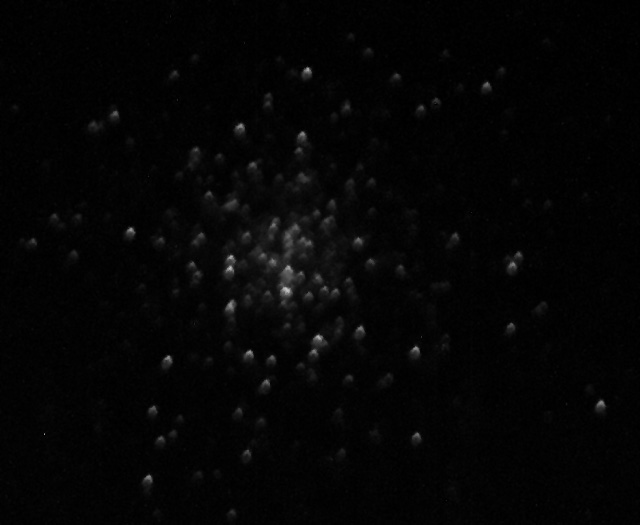
M13: the 5.8 arcsec FWHM stat only begins
to suggest how bad the comatic stars look
with the R-C grossly miscollimated.
(Cropped but not resampled; this is a full scale image.)
I undid what I did, as best I could recall, and that improved the situation considerably. At a guess, I undid about 75% of the error. I took some images to record the mess.
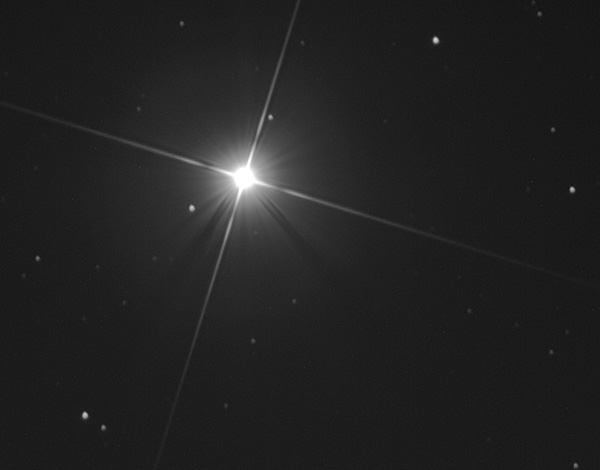
Vega: collimation still way off.
Stars are
3.8" - 4" FWHM
(Image resampled for display.)
Less than half a turn of one collimating bolt is the difference between really dreadful images and perfectly good ones; far smaller adjustments matter a ton. Evidently, I should pick one alignment method and stick to it. Not the laser collimator reflecting back on itself. Shoulda knowed better! This is not a Newtonian. There is no flat. Etc etc. Next, I'll follow the A-T directions and collimate on a star (real or artificial). I'll modify the method by using a CCD rather than an eyepiece, probably the ST2000XM in Nebulosity's frame and focus mode. I want to be able to watch the image while I turn the bolts, not walk back and forth to an eyepiece. A Hubble artificial star is enroute from Agena for next time; for this time, I'll use whatever tools and techniques fall to hand.
8/11/2011. Cloudy today, clear tonight! A happy reversal of the usual meteorological habit allowed me to collimate on grossly out-of-focus Arcturus in the twilight by trying to center the shadow of the secondary. I began the night with improved but still imperfect collimation.
I pulled a few useful numbers before going back to twisting the secondary collimation bolts. I measured the focus offset from Baader L filter to the 10nm Schuler-Ha at 140-160 Robofocus units outward. Then I replaced the Schuler in the CFW-8a's fifth filter position with a Baader 7nm Ha filter and measured the offset again. The difference was only about 40 Robofocus units, surely close enough that I can use the OAG without adjusting it when transitioning from wide- to narrow-band imaging. Recheck after refining collimation (which will provide a better defined point of best focus). Score one for my side.
300s frames clearly show that the R-C is still out of collimation. After a little more trial and error, I found that simply aiming into a bright area of the Milky Way and taking "frame and focus" images with 5-6 second exposures produced a wealth of stars to use as collimation targets. I defocused the field by about 1000 steps and then viewed the download at 200-400% on the netbook screen. Turning the secondary bolts moves the aiming point considerably, but the rich star field insures that at least one (and often many) suitable stars are near the center of the field. It beats chasing one star all over creation. I set about the tedious business of making donuts symmetrical. After a few trips around the secondary, you get a feel for how to keep the shadow going in one direction or another. This will eventually get the job done. When clouds moved in I was not quite there, but definitely closer. I have in-focus PSF's in 10s exposures back to the 2-seconds-and-change regime (less than half the beginning bloat). Out of focus field stars are still only approximately symmetrical, and stretching the 10s photos shows that the defocused fuzz is still off to one side. This is what progress looks like, and it looks ugly.
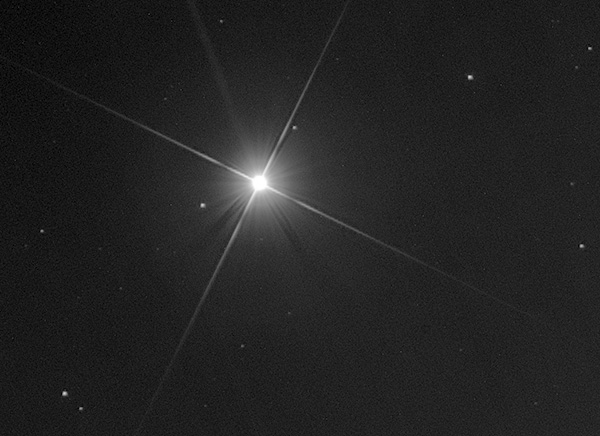
Vega: collimation getting close.
Stars are
back down to 2" but still comatic.
(Image resampled for display.)
Sooner or later, I'm going to drop an Allen wrench down the tube. There's too much fumbling around in the dark to think that will never happen. So I asked Bob of Bob's knobs if he'd made any for the AT10RC. He was testing some, he said, and offered to barter a set for a good photo of them in action for his website. Good deal, I said, and set about measuring the OEM collimating bolts and secondary housing to help define specs. A comedy of errors ensued while measuring in the dark, then in the rain, and finally at my leisure. Even then I screwed up the labelled photo I sent Bob. Here's the corrected one I finally managed to produce:
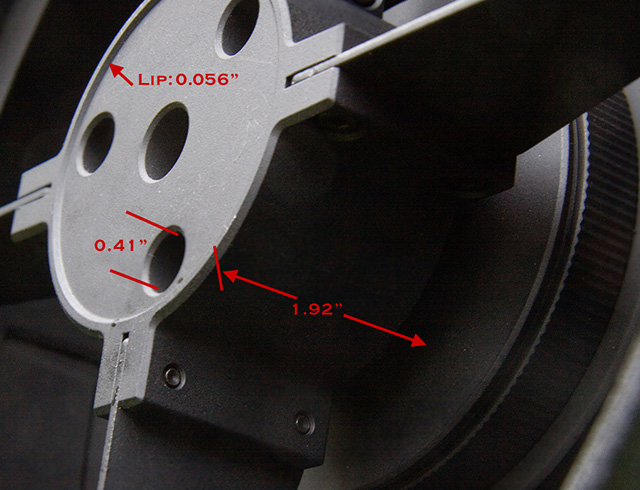
Critical dimensions for Bob's Knobs.
Next morning, I tried Jared Wilson's method of collimation: choose your line of sight to just graze the edge of the secondary holder and align it with one vane and its reflection. Then tweak collimation until you get the hall of mirrors effect shown below. I've slewed the telescope to near the western horion to make it easy to stare down the tube. Turn the secondary's collimating bolts to maximize symmetry when sighting past a horizontal vane, then do the same for a vertical one. Iterate as needed until you see the Hall of Mirrors receding straight into the distance beside as well as over or under the secondary. As Jared noted, I can't make an adjustment so small that I can't see its effect, which is the gold-standard for sensitivity. If proper collimation is found at the unique position marked by maximally symmetrical reflection effects, then we've got a royal road to excellent alignment. Gimme some starlight and I'll let you know if this is so.
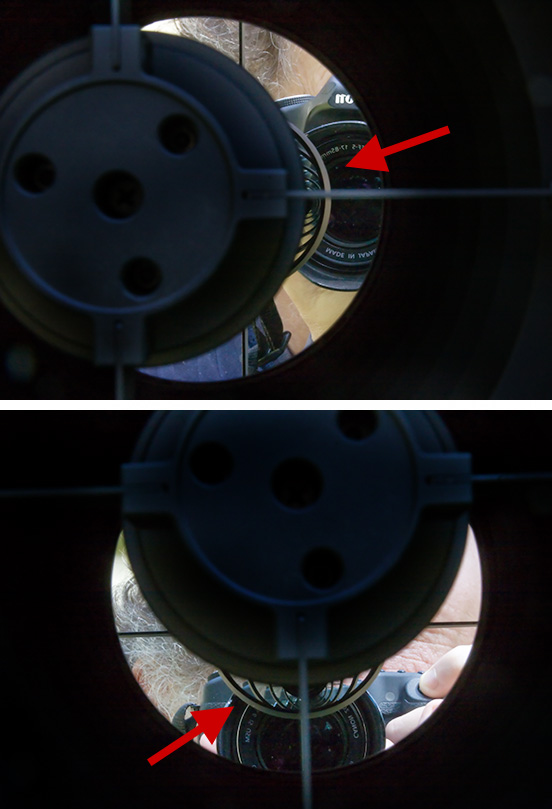
Jared Wilson's Hall of Mirrors method for collimating the AT10RC,
first in X, then in Y. In the top frame, things are still just a smidgen off.
(8/16: but note that after star-aligning, this is how things still look.)
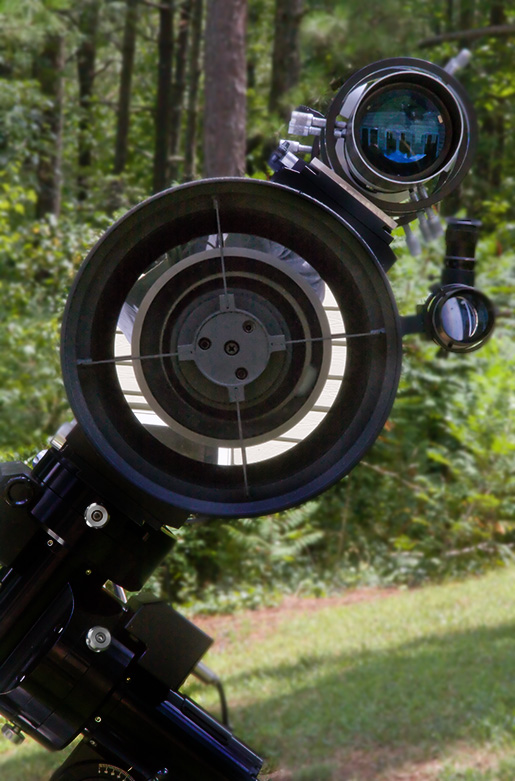
Straight down the barrel. Are we
collimated? I see
one non-concentric circle arising from.... what?
Anyway, ready for star trials.
8/14/2011. Next time you're feeling flush, consider ordering one of these: collimating ring for AT10RC focuser. The price shown includes European VAT which disappears when you use an address outside the EU. What the VAT exclusion giveth, shipping more than taketh away. On short exposure frames from the most recent collimating session, I'm seeing 2.4 arc second stars on one side of the frame and 1.8 arc second stars on the other side. For the best results, this might be a bullet that must be bit. First: patience and frugality. Refine alignment to the max using the tools and resources at hand, then buy this extra adjustability if it's still needed.
So far, I have improved my images by refining guiding, focus, and am working on optical collimation. Once those three are nailed, the next best ways to improve performance are expensive: better seeing, bigger and better CCD real estate, and darker, clearer, higher, western skies.
It strikes me that I seem to be on a quest for 1 arc second images. This may not be realistic, and western NC's seeing may not permit such sharpness even if I control every variable. Achieving "seeing limited images" is a nice goal, but when observing downwind of the Blue Ridge, "seeing limited" can still be appreciably limited.
8/15/2011. I placed the Hubble artificial star on a tree about 150 feet from the telescope. As expected, even overcast noontime light is much too bright for a trial. In the twilight, either the blue wideband filter or the L filter is the one to use. The artificial star is very dim at H-a and relatively dim in G and especially R. The light face of the HOAS (Hubble Optics Artificial Star) is very bright in the dusk; getting the star points to shine conspicuously means waiting for deeper twilight. I covered all but the middle star to simplify the display. The remaining star was, at the 150 foot range used tonight, somewhere around half a magnitude brighter than Vega. In the twilight, I took a series of exposures of the artificial star, drew lines in Photoshop bisecting the E/W and N/S vane shadows and then drew a circle centered on their intersection encompassing the star image. I adjusted the secondary collimation so that the outer edge of the star's large, defocused ring was just contained in a circle centered on the vanes' shadow. Tonight the HOAS got me close.
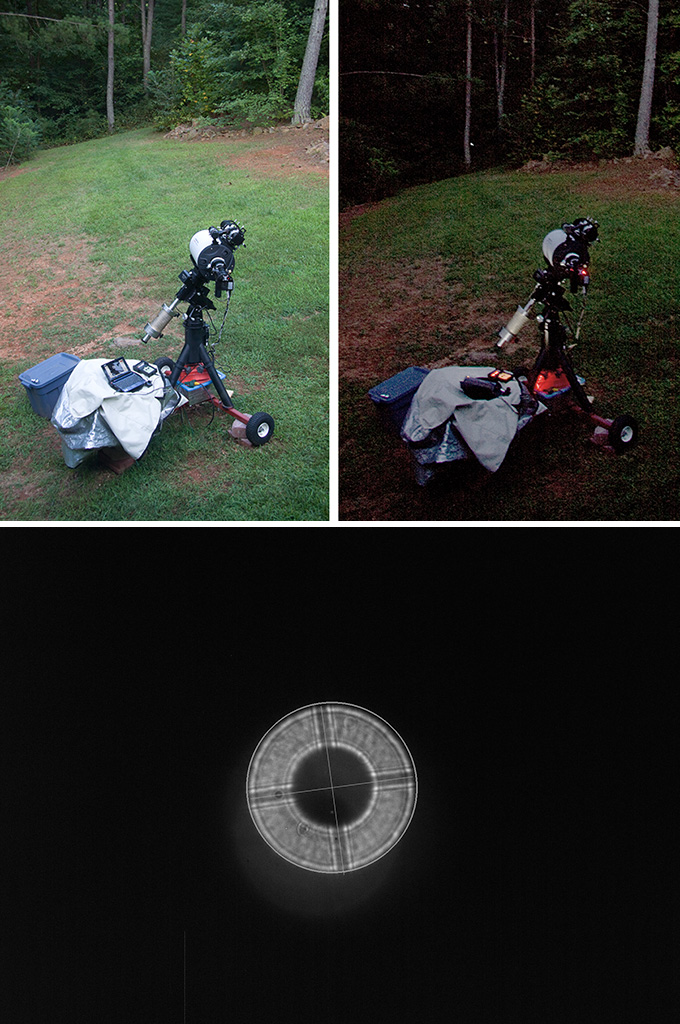
On the collimation range:
The Hubble Optics Artificial Star in the pines.
Circle and crosslines added in Photoshop for measurement purposes.
See the small misalignment between the defocused star and the circumscribed circle?
I suspect that small-seeming misalignment is an absolute offset, not something small magnified by the defocused image. That is, if I brought the PSF down to 3 or 4 pixels, the misalignment would still be the same handful of pixels, a gross error. I've determined that I can reach focus easily by inserting the Maxbright diagonal ahead of the ST2000XM and will try using that improvised "extension" the next time I use the HOAS. I know: collimating behind a diagonal is asking for trouble, but you have to choose your issue: too large a PSF or collimating behind a diagonal. At least it's a very good diagonal. Also: the chrome trailer ball catches the Sun for a very bright visual target if you're ever inclined to try visual collimation. It's way too bright for CCD capture, even with the 7nm Baader Ha. Even as I write that, it finally occurs to me that the Point Grey Chameleon I use for solar imaging would probably be excellent for all these collimation tasks, including catching the specular reflection from the trailer ball.
Aiming into a bright star field in Lyra helped achieve a reasonably exact alignment. About a tenth of a turn of two collimation bolts cleared most of the remaining miscollimation and made circular donuts of defocused stars. A few very small tweaks evened out the light around the Cheerios made after bringing the stars nearer focus. Eventually, stars in the best possible focus displayed symmetric scatter in the "fine focus" CCD window (but lousy seeing made judging that last, telling detail tough). Here's M13 as a reality check:
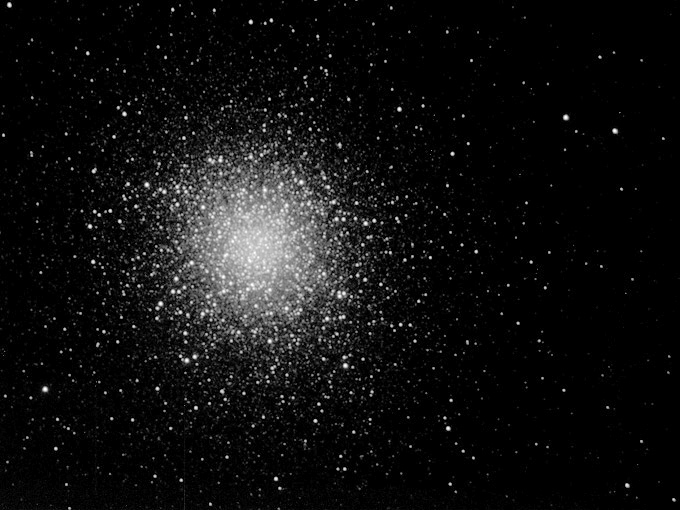
M13. 8x150s L
I believe the original is slightly soft owing to
seeing,
not miscollimation.
That's a significant improvement over the mess at the top of the page, no? I'd like to compare this experience with Jared's method; that is, I'd like to see if it gets me as close to collimation as the HOAS did. Tonight I messed with the artificial star after finding Jared's hall of mirrors and before testing on real stars. Since I will mess up the collimation to install Bob's Knobs, I'll have a chance to make that comparison later this week.
I want to keep all the collimation notes on one page, so images and the usual discursive account of recent nights continue on the next page, achronistically with collimation nites and notes which I will continue to accumulate below.
8/21/2011. Bob's Knobs arrived. These are prototypes for the AT10RC. I'd sent preliminary measurements and promised a beauty photo for Bob's website and was happy to engage in some engineering trials. Bob sent a set of 55mm and 50mm knobs with a note to try the 50's first. He knows what he's doing, because the 50's fit just fine. There's ~3mm to spare, and the dust cap just fits over them. In fact, the dustcap just touches the knobs and does not snap quite as tightly into place as it once did. It fits well enough. And this is not all bad, since I've messed up the A-P mount's park position tugging the dustcap to remove it from its previously very tight mooring.
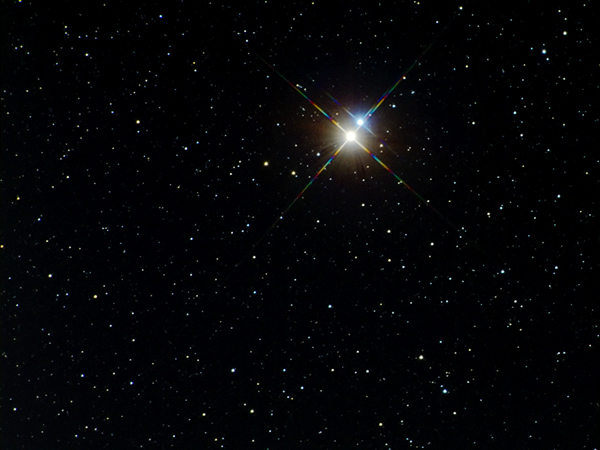
Albireo, Beta Cygni, a colorful double star
1x150s RGB
Hall of Mirrors Alignment only.
I did a casual job of "Hall of Mirrors" alignment and finished up with a couple of very small tweaks of the knobs based on the "frame and focus" and "fine focus" images in the vicinity of Albireo. I didn't expect to get the chance to do this tonight but there were stars overhead when I went out to bring the bird feeder in. So tonight's trials are without the benefit of a long cooldown or airing out of the tube. The slight top-heaviness of in-focus stars and the presence of a persistant hot-spot at the top of every out of focus donut is due to tube currents. Images made an hour into the session are noticeably improved.
I was concerned that the smallish (5/8-inch) knobs would not allow the precision adjustments I could make using the longer arm of an allen wrench, but the improved tactile feedback of the hands-on knobs more than compensated. I tried improving on the 50mm knobs by cutting the 55's down to 47 on the lathe. Nope: the thread run is too short. The dustcap completely clears the knobs on the shorter bolts, and they still have room above the secondary holder for some adjustment, but their threads bottom out before the tips of the bolts press against the secondary. 50mm it is. After replacing the buggered 47mm with the 50mm set, I recollimated as closely as I could with Jared's Hall of Mirrors technique (slew to the east or west, put your eye close to a horizontal vane of the secondary holder, make sure the reflection of your pupil is bisected by the vane, turn knobs until the hall of mirrors is long and straight; repeat for a vertical vane; iterate until true of both horizontal and vertical vanes).
Score Bob's Knobs a success: it's not that I can adjust collimation better using Bob's Knobs than I can with an allen wrench, it's that there is no reason not to collimate. No hunting for tools or going inside for this or that. If a collimation issue comes up, just fix it. Like focusing, like polar alignment.
Also, as with focusing and polar alignment, I have software here which promises to assist with collimation.
8/22/2011. This is the finest night of the second half of the year, 2011's first "autumnal" evening. Cool, dry, and clear. And not to be wasted fighting with software for polar and optical alignment. I did the best I could with manual methods and got the shutter open as twilight ended. During the day, I had repeated Jared Wilson's Hall of Mirrors alignment. Careful daytime collimation again required adjustment under the stars, but very, very little. Two small tweaks of two knobs removed the last bit of asymmetry in M92's stars. On-axis FWHM's dropped from 3.3 to 2.8 arc seconds, and that's the best I could get owing to lively air; off-axis guide star images improved noticeably, and the amplitude of the guiding tattletale plot was cut in half.
I ordered a 10-inch AC/DC fan from Amazon to help the Ritchey's built-in fans move warm air from the 'scope. I can have everything ready for imaging in ten minutes, but that's pointless if it takes 2 hours to flush out tube currrents. BTW, tube currents are strong enough to survive the 3 muffin fans in the back of the mirror cell; leave the fans running and they may lessen the tube currents' effects, but they're still visible. Surprises me. I wonder if the multiple light baffles impede the escape of warm air? Make a point of aiming at the zenith while cooling down to minimize whatever "pooling" effect the baffles may have on flowing air.
[November 2011: I haven't touched the collimation since this entry and it's holding very well. I'll try MetaGuide with the Point Grey Chameleon video camera as part of a suite of tests involving refined airflow and dead-on polar alignment after all the parts have arrived; I'm waiting for an A-P precision azimuth adjuster. It occurs to me that what I've been describing as "tube currents" may well be a boundary layer clinging to the surface of the big quartz rock at the bottom of the tube. I have some tiny fans here that I hope will disrupt the boundary layer, if it exists. More when I know more.]